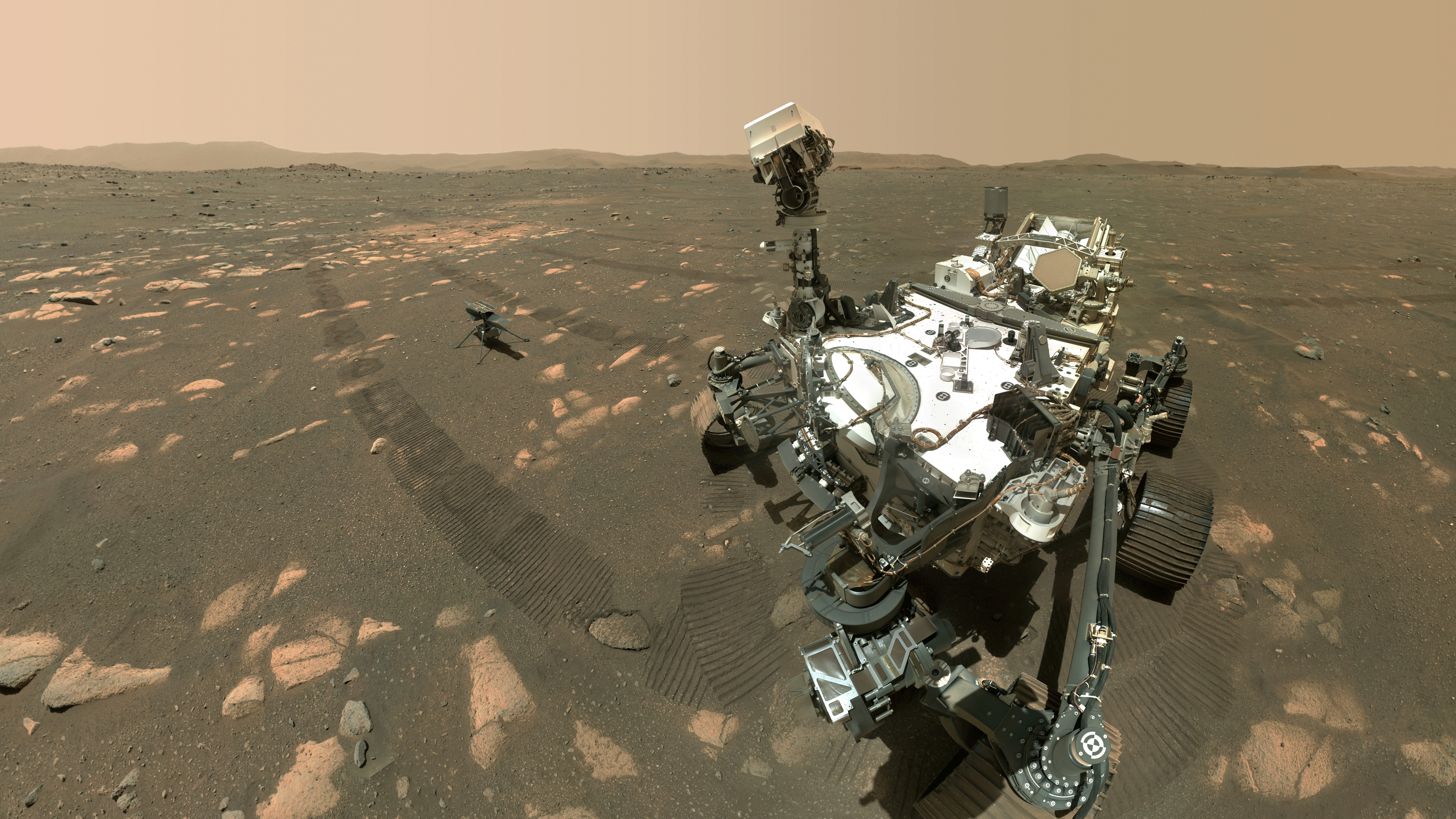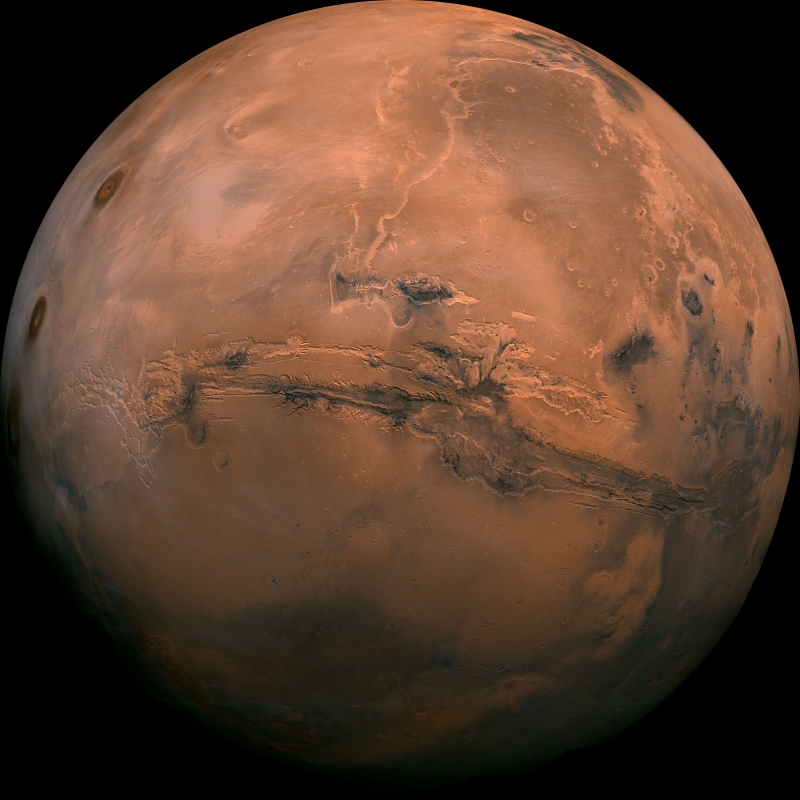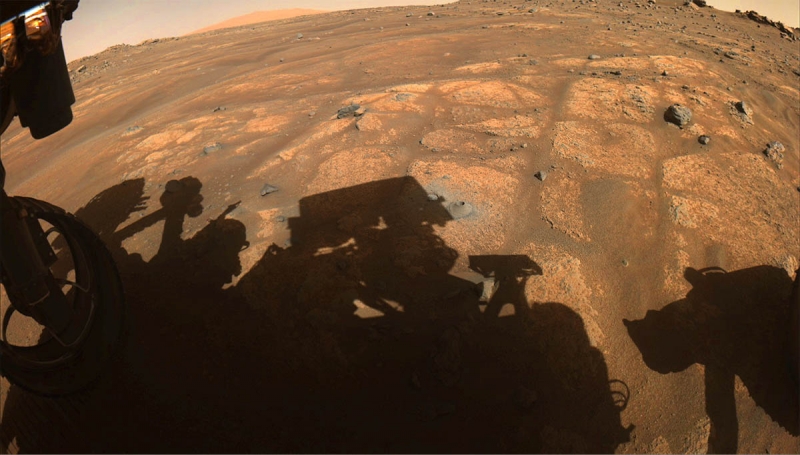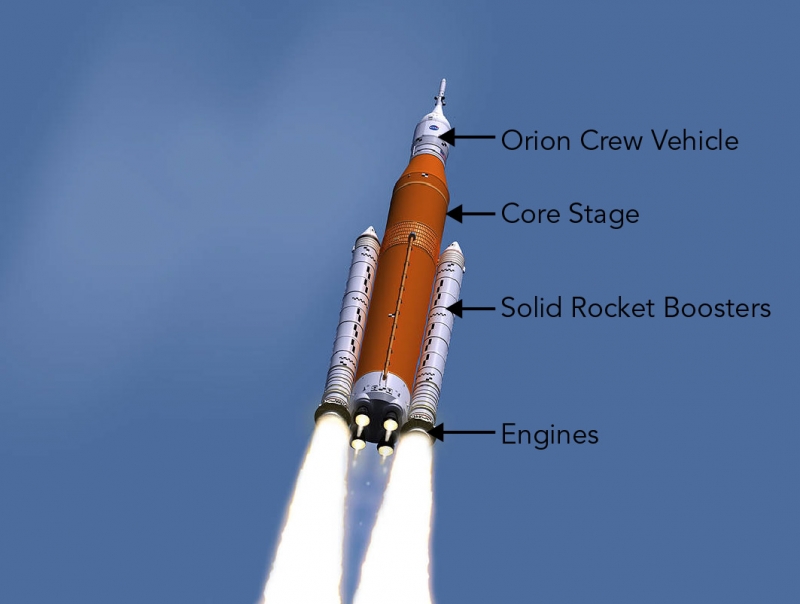Destination Mars

The face of the planet Mars (NASA).

The face of the planet Mars (NASA).
How does this align with my curriculum?
Discover how space agencies have explored the Red Planet in the past and present and learn about the future of human spaceflight to the red planet.
People have been fascinated by the planet Mars for thousands of years. Maybe it’s because you can see it without the help of a telescope. With telescopes, robotic orbiters, landers and rovers, we have learned a lot about Mars. The next big step is going there ourselves!
Why Go to Mars?
Mars may look warm and inviting, but it is actually a cold, dry planet with air we cannot breathe. The suffocating atmosphere contains 96% carbon dioxide and almost no oxygen. So if we aren’t going for the weather, maybe we are going for the view. The martian landscape is similar to that of Earth’s with canyons and mountains and even polar ice caps. It even has seasons like Earth’s.
But, are landscapes and seasons why people want to go there? Yes and no. Scientists have long believed that billions of years ago, Mars may have been more like Earth, with warmer temperatures and lots of liquid water. This makes Mars the most likely planet in our solar system, other than Earth, to have supported the evolution of life. Finding signs of past life is a big reason why people want to go to Mars.
What was Martian life like?
Scientists believe that the living things on Mars were likely microorganisms, like bacteria. It is exciting to wonder if Martian microorganisms could still be living on Mars. Even if life is never found outside Earth, exploring other planets satisfies human curiosity about our place in space.
Image - Long description
Shown is a colour photograph of Mar which is technically a mosaic of 102 separate pictures. The planet is a rusty brown colour with darker slashes and swirls which are landforms such as the Valles Marineris canyon, which is visible near the centre of the planet.
First We Sent Robots
Since the 1960s, the United States National Aeronautics and Space Administration (NASA) has launched many successful robotic missions to Mars. The earliest missions sent spacecraft on a planetary "fly-by". Then, orbiters were sent to study Mars. These were robots that could observe the surface from an orbit, much like our Moon. Eventually robotic landers explored the Martian surface.
As of 2021, NASA has three orbiters studying Mars from space. It also has one lander and two rovers on the planet's surface. The rovers, called Perseverance and Curiosity, are busy investigating Martian geology. They are looking for liquid water, and searching for signs of life in soil and rocks. The Indian Space Research Organisation also has an orbiter around Mars. It has had its Martian Orbiter Mission studying the Martian atmosphere and surface from space since September 2014.
Did you know?
There are also several inactive landers and rovers from past NASA Mars missions still on the planet's surface.
Image - Text Version
Shown is a colour photograph of the surface of Mars. A large shadow cast by the Perseverance rover is in the foreground. A dark, shadowy drill can be seen at the bottom left.
Perseverance wasn’t all alone on Mars. It came with a cool new partner Ingenuity. Ingenuity is a tiny robotic helicopter and the first aircraft to ever fly on another planet. It flew successfully for the first time on April 19, 2021. The success of this test opens the doors to more aircraft in future Mars missions. Who knows, maybe someday you could pilot a robot like Ingenuity.

Perseverance's selfie with Ingenuity (Source: Public domain image via NASA/JPL-Caltech/MSSS).
Image - Text Version
Shown is a colour photograph taken on the Surface of Mars by a camera on the Perseverance rover. The rover has a long arm reaching out of the frame. On this arm is a camera taking the picture. The entire rover is in view. On the Martian surface you can see tire tracks going off into the distance in the direction that the rover came from. Flying nearby is Ingenuity, the tiny robotic helicopter. The gif shows two positions for a camera on top of the rover.
The American rovers are not alone on Mars. They now have company in the form of Zhurong 祝融;, a Chinese rover that landed in May of 2021. It is named after the god of fire in Chinese mythology. Like the American rovers, its mission objectives are to learn about the plant's geology and finding traces of water and life.
A 2022 launch is also planned for the Rosalind Franklin rover to land on Mars. This rover is being jointly built by the Russian Federal Space Agency (Roscosmos) and the European Space Agency (ESA). Its main purpose is to look for signs of life on Mars by studying atmospheric gases and exploring the surface.
The Challenge of Getting People to Mars
Even though Mars is a planetary neighbour, it is still very far away. The distance between Earth and Mars is constantly changing due to their orbits around the Sun. The closest Mars gets to Earth is around 56 million kilometres. It would take 64 years of non-stop driving to travel this distance at a highway speed of 100 km/h. With current space technology, robotic missions take about 8 months to reach Mars.
To send people and supplies to Mars, NASA is developing the most powerful rocket ever made. The Space Launch System (SLS) will launch up to four astronauts in a spacecraft called Orion.
Did you know?
Orion was a hunter in Greek mythology, and it is a constellation in the winter sky.
Before going all the way to Mars, the SLS will be tested during the Artemis mission. This mission is to the Moon, which is a mere 386,000 kilometres away. If all goes well, the first crewed mission to Mars will take place in the 2030s. So the first humans to set foot on Mars could be one of today's elementary school students.
Below is an artist's image of the SLS. This version of the SLS will be used for the Moon mission in the 2020s. The core stage holds the main engines and their fuel. The solid rocket boosters provide thrust for "blast-off."
Image - Text Version
Shown is a colour illustration of the Space Launch System rocketing into a clear blue sky. At the nose end is the white, cone-shaped Orion Crew Vehicle where the astronauts would be. Attached to this is a dark rust-coloured core stage. This holds the fuel for the engines which are attached to it at the tail end of the rocket. On the sides of the core stage, at about two-thirds the length, are two white solid rocket boosters. These provide additional thrust for takeoff. In the photo both the rocket engines and the thrusters are shooting out white hot gases.
SpaceX, a private American aerospace company, is collaborating with NASA for a future human spaceflight to Mars. SpaceX's Dragon capsule, launched by their Falcon 9 rocket, has been delivering supplies to the International Space Station since 2012. More powerful versions of the capsule and the rocket are used in Starship, which will be used for the Martian mission.
The Challenge of Living on Mars
So far, NASA has no plans for establishing a permanent settlement on Mars. But even for a mission with a short stay on the surface, keeping astronauts healthy during the long trip to Mars will be challenging. This is where The International Space Station (ISS) comes in. Keeping astronauts healthy on the ISS has really been the first step in getting to Mars.
Lots of ongoing research aboard the ISS is helping scientists figure out what is best for astronauts and ensure their health for long spaceflights. Researchers are also considering how to protect astronauts and sensitive cargo such as food from cosmic radiation. Lots of effort is also going into understanding what kind of fruits and vegetables are best grown in microgravity. Just as important is learning how to ensure good mental health for small groups of astronauts living in a small space for a long time - kind of like being trapped at home with your parents during the coronavirus pandemic!
On the journey to Mars, the further astronauts get from Earth, the more challenging communication becomes. Two-way communication between Earth and Mars takes about 20 minutes. That is a long time to wait for an answer from Earth in case of an emergency millions of kilometres away from home.
Would you be ready for the challenge?
Given all that you have learned about getting to Mars, do you think you would want to go? Learn more about the lives of Canadian astronauts and what it takes to become one at the Canadian Space Agencies Junior Astronauts Program.
Learn More
The ExoMars Programme 2016-2022
This article by the European Space Agency (ESA) provides a summary of the goals of the ESA/Roscosmos ExoMars missions.
The Challenges of Getting to Mars
This playlist of 7 videos from NASA’s Jet Propulsion Laboratory covers the main challenges to be addressed for human exploration to Mars.
Top Ten Ways ISS Is Helping Us Get To Mars (2015)
This article by NASA explains how future Mars missions will benefit from research on the International Space Station, especially with respect to keeping astronauts healthy.
Red Planet InSight: Why Do We Keep Going Back to Mars? (2018)
This article by Space.com covers the objectives of the Mars missions, their biggest discoveries and what is left to understand.
Kennedy Launches NASA's Journey to Mars (2016)
This video (3:58 min.) from the NASA Kennedy Space Centre summarises how NASA's past and current space exploration paves the way for future robotic Mars missions and a crewed Mars mission.
Mars Exploration Missions
This webpage from NASA lists the most major robotic mission to Mars, past, present and future.
References
Mars Exploration Program.NASA. (n.d.) Mars Today: Robotic Exploration: Mars Overview
NASA. (n.d.) Mars Exploration Missions.
NASA. (n.d.) Moon to Mars Overview


